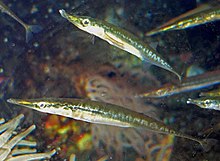Stickleback-like
| Stickleback-like | ||||||||||||
|---|---|---|---|---|---|---|---|---|---|---|---|---|

Three-spined stickleback ( Gasterosteus aculeatus ) |
||||||||||||
| Systematics | ||||||||||||
|
||||||||||||
| Scientific name | ||||||||||||
| Gasterosteales | ||||||||||||
| Gill , 1872 |
The sticklebacks (formerly order Gasterosteiformes , currently part of the order Gasterosteales ) are related to the bony fish (Osteichthyes) from the order of the perch-like (Perciformes).
features
Sticklebacks are small, elongated fish and reach lengths of 4.5 to 22 cm. All stickleback species lack scales . Instead, the body is surrounded by bone plates. Many species also have hard skin and fin spines. The gill openings are usually small. The mouth is small and protractile (can be turned forward) or tubular. The pelvic fins are small or absent. The anal and dorsal fin are shifted far back in many species.
distribution
Sticklebacks live in the sea, fresh water and brackish water in the northern hemisphere . The three-spined stickleback is also found on the south coast of Greenland .
nutrition
All stickleback species are carnivorous , mostly from small crustaceans , the freshwater species also from insect larvae .
Reproduction
Almost all stickleback species practice some form of brood care and take care of the eggs until the young fish hatch. Sticklebacks build nests from plant parts and lay the eggs in them.
External system
|
According to Near et al., 2013
|
|
According to Betancur-R. et al., 2013
|
The sticklebacks belong to the perch-related fish ( Percomorpha ) and had the rank of an order there for a long time. Phylogenetic studies show, however, that they are closely related to the bull relatives (Cottales) and the eel mother relatives (Zoarcales). It is not yet clear whether the Cottales or the Zoarcales are the sister group of sticklebacks. In a revision of the bony fish system from 2013, Betancur-R. and colleagues the stickleback-like together with the eel-mother relatives, the bullhead relatives and the Skilfishes (Anoplopomatidae (suborder Anoplopomatales)) in the subordination of the bullhead-like (Cottoidei) within the order of the perch-like (Perciformes).
The two cladograms on the right show the alternative possible relationships.
Internal system
The sticklebacks include the stickleback family, in which 9 to 20 species ( fishbase ) are placed, depending on the author , and three other species that occur on the coast of the northern Pacific and belong to the families Aulorhynchidae and Hypoptychidae, which are the Hypoptychidae, to which two species are assigned, is probably a non- monophyletic family.
The family relationships are shown in the following cladogram :
| Stickleback-like |
|
||||||||||||||||||
|
|
The pegasidae (Pegasidae) are today the pipefish-like assigned (Syngnathiformes). The Indostomidae , a family of very small and externally similar to sticklebacks similar to freshwater fish from northwestern Southeast Asia, belong to the order of the gill-slit-eel-like (Synbranchiformes) according to molecular biological research . The external similarity has therefore developed convergently .
literature
- Kurt Fiedler: Textbook of Special Zoology, Volume II, Part 2: Fish , Gustav Fischer Verlag Jena, 1991, ISBN 3-334-00339-6
- Joseph S. Nelson : Fishes of the World , John Wiley & Sons, 2006, ISBN 0-471-25031-7
- Bent J. Muus, Jørgen G. Nielsen: The marine fish of Europe in the North Sea, Baltic Sea and Atlantic. Kosmos, Stuttgart 1999, ISBN 3-440-07804-3 .
- Hans A. Baensch , Robert A. Patzner: Mergus Sea Water Atlas Volume 6 Non-Perciformes (Non-Perciformes) , Mergus-Verlag, Melle, ISBN 3-88244-116-X
- Günther Sterba : The world's freshwater fish. 2nd Edition. Urania, Leipzig / Jena / Berlin 1990, ISBN 3-332-00109-4 .
Individual evidence
- ↑ a b c d Ricardo Betancur-R., Richard E. Broughton, Edward O. Wiley, Kent Carpenter, J. Andrés López, Chenhong Li, Nancy I. Holcroft, Dahiana Arcila, Millicent Sanciangco, James C Cureton II, Feifei Zhang , Thaddaeus Buser, Matthew A. Campbell, Jesus A Ballesteros, Adela Roa-Varon, Stuart Willis, W. Calvin Borden, Thaine Rowley, Paulette C. Reneau, Daniel J. Hough, Guoqing Lu, Terry Grande, Gloria Arratia, Guillermo Ortí : The Tree of Life and a New Classification of Bony Fishes. PLOS Currents Tree of Life. 2013 Apr 18 [last modified: 2013 Apr 23]. Edition 1. doi: 10.1371 / currents.tol.53ba26640df0ccaee75bb165c8c26288 , PDF ( Memento of the original from October 13, 2013 in the Internet Archive ) Info: The archive link was inserted automatically and has not yet been checked. Please check the original and archive link according to the instructions and then remove this notice.
- ^ A b c d Thomas J. Near, A. Dornburg, RI Eytan, BP Keck, WL Smith, KL Kuhn, JA Moore, SA Price, FT Burbrink, M. Friedman & PC Wainwright. 2013. Phylogeny and tempo of diversification in the superradiation of spiny-rayed fishes. Proceedings of the National Academy of Sciences of the United States of America. 101: 12738-21743. doi: 10.1073 / pnas.1304661110 , PDF
- ↑ Hans-Joachim Paepke: The sticklebacks: Gasterosteidae , Westarp Wissenschaften, Magdeburg 1996, ISBN 3-89432-492-9
- ↑ Ryouka Kawahara, Masaki Miya, Kohji Mabuchi, Thomas J. Near, Mutsumi Nishida: Stickleback phylogenies resolved: Evidence from mitochondrial genomes and 11 nuclear genes . Molecular Phylogenetics and Evolution 50 (2009): pp. 401-404, doi : 10.1016 / j.ympev.2008.10.014
Web links
- Sticklebacks on Fishbase.org (English)
